
Top 10 EASY Day Trips From Tokyo That Will Be Unforgettable
The Golden Triangle in Japan, which includes Tokyo, Kyoto, and Osaka, is the most popular itinerary for tourists. But Kyoto and Osaka are not the only cities that are worth visiting if you’re staying in Tokyo. There are tons of amazing destinations that are closer to Tokyo and worth checking out. From Edo-like neighborhoods to fascinating Buddha statues, there’s plenty to discover surrounding the Tokyo area. And it’s all easily accessible with public transportation. Here are the top 10 easy day trips from Tokyo that are worth putting on your itinerary!
The Top 10 Best Day Trips from Tokyo
Here are the top 10 best day trips from Tokyo:
- Kawagoe
- Kamakura
- Yokohama
- Fujiyoshida
- Ibaraki Prefecture
- Nikko
- Hakone
- Sawara
- Karuizawa
- Yamagata
- ?? Special Mention!
1. Kawagoe (One of my Favorite Day Trips from Tokyo)

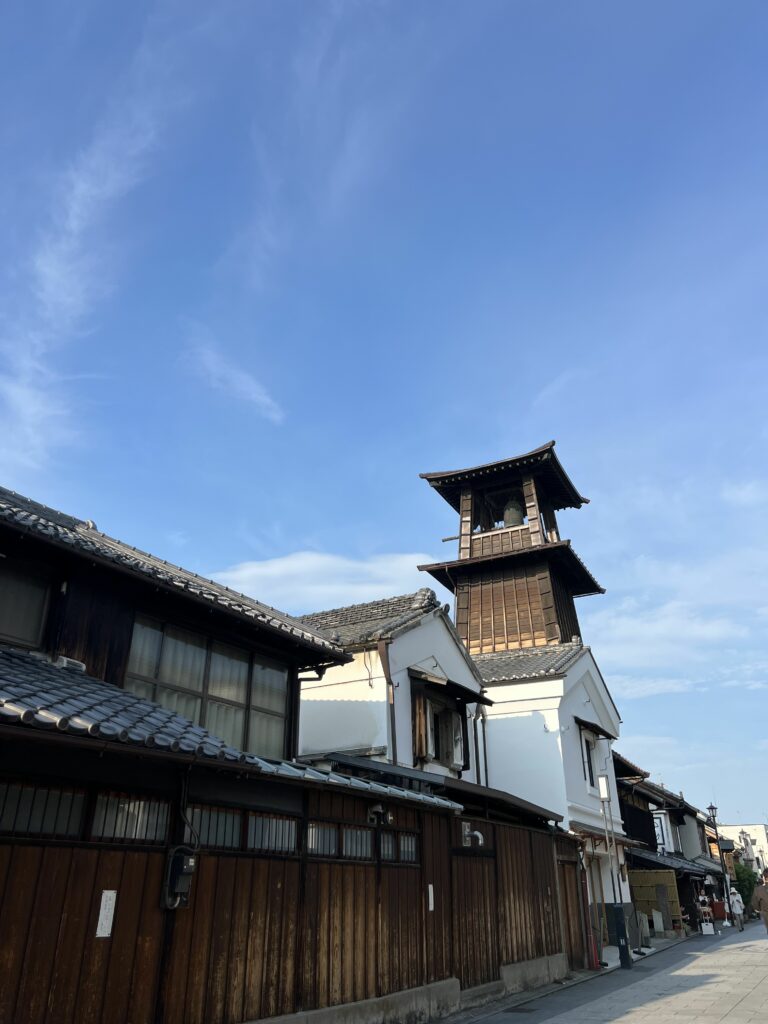
Get transported back to the Edo Period.
Located 30 minutes northwest of Tokyo, Kawagoe is a charming Edo-period town known as Saitama’s Little Edo. During the Edo period, Kawagoe developed around the Kawagoe Castle as a strategic defense. It was also en route to modern-day Tokyo. As a result, it flourished commercially, mainly trading agricultural products, textiles, and furniture. Wealthy merchants built fireproof warehouse-styled buildings called Kurazukuri after a devastating fire in the 1800s.
The Kurazukuri architecture has clay walls and layered tile roofs, giving it a distinct look characteristic of the Edo period. There are more than 200 kurazukuri buildings in Kawagoe, with most of them functioning as shops selling traditional wares, snacks, and textiles on the bottom floor. They all form the famous Little Edo neighborhood in Kawagoe.
Activities and Sights to See
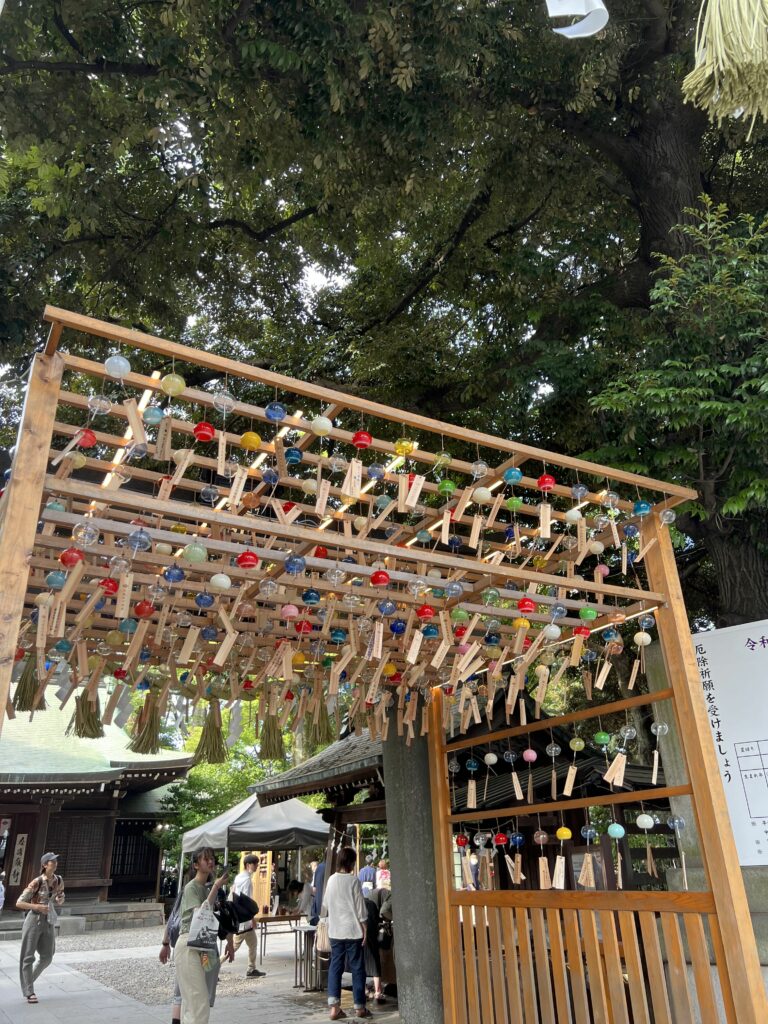
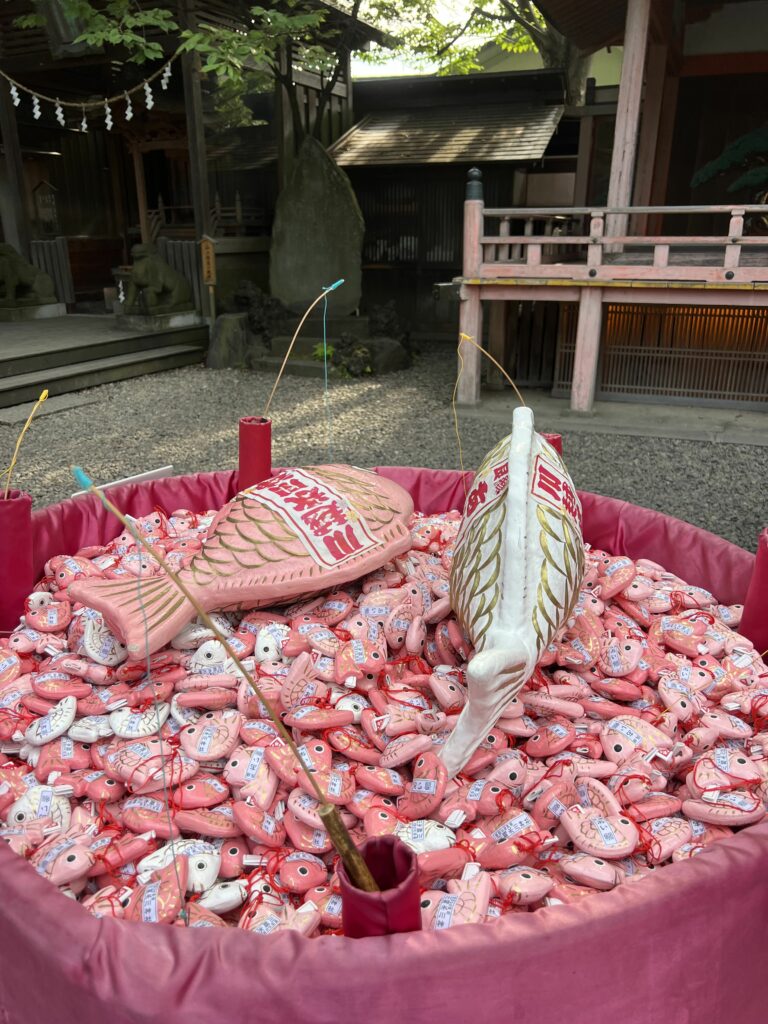

Walk and shop around this historical district! Immerse yourself further by wearing traditional Japanese clothing like a kimono or yukata. There is also a famous sweets street called Kashiya Yokocho or Penny Candy Lane, where you can find cheap traditional sweets and Kawagoe’s famous sweet potato. Visit the Toki no Kane bell tower, the historical landmark of Kawagoe that tells time just like it did back in the day. Then, stop by Starbucks located in a kurazukuri house and enjoy the interior with a cold drink.
Aside from the beautiful architecture, my favorite destination in Kawagoe is the Hikawa Jinja or the Hikawa Shrine, dating back more than 1500 years. Because two sets of shrine deities are married, people visit the Hikawa shrine for good luck in romance or marriage. The shrine is so beautiful: dozens of glass windcatchers blow in the wind, and there is an ema (wood prayer plate) tunnel you can walk through. Their omikuji (good luck papers) are special, too: the workers hide them in small wooden red carp charms that you can keep afterward!
I loved visiting Kawagoe from Tokyo on my trip to Japan in June and July, and I highly recommend it. I always look back to my pictures and my red carp omukuji as a reminder of good times. It’s charming, loaded with history and architecture, and the perfect way to spend an afternoon. You can read my blog here for more information on how to get there and how to best enjoy this charming town. This is one of my favorite day trips from Tokyo to take!
How to get there from Tokyo: Take the JA Saikyo Line from Shinjuku Station to Kawagoe Station. It takes one hour.
2. Kamakura
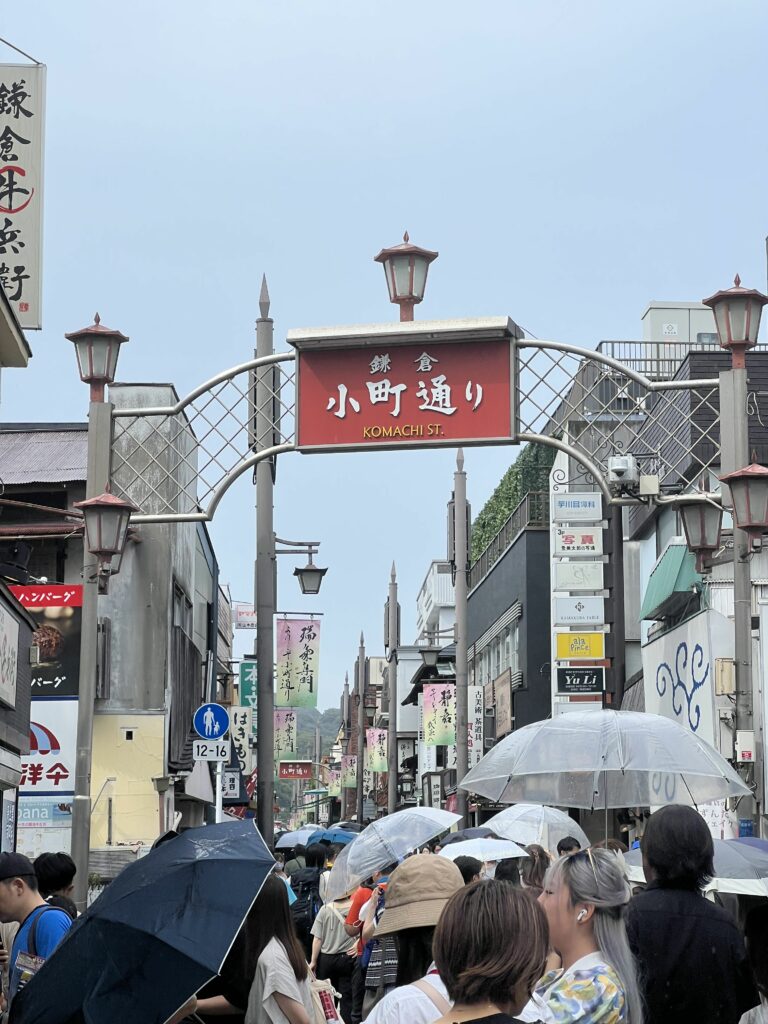
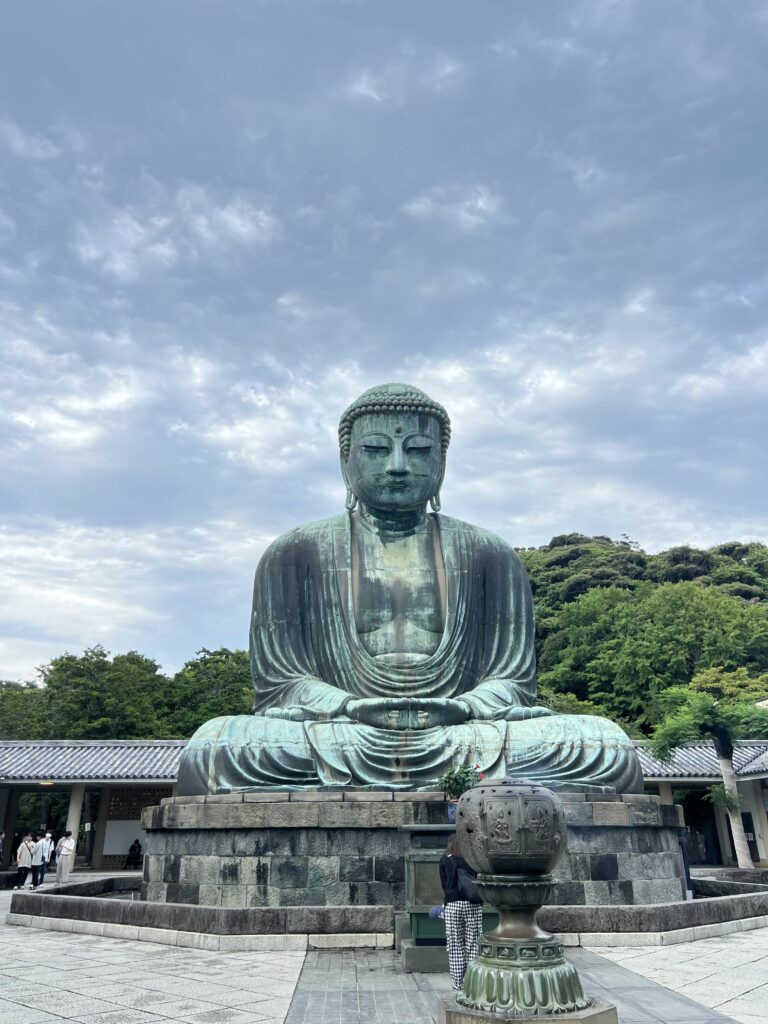
Where temples meet the sea.
Kamakura is famous for its Great Buddha Statue and surfing! It’s a coastal town south of Tokyo that started as a small fishing village and eventually became the second capital of Japan during the Kamakura period. It was also the first military government in Japan’s history. Now, it’s known for its beautiful temples, stunning beaches and nature, and great walking streets.
Right in front of the Kamakura station is Komachi-dori street, originating as a small street market and is now the most popular shopping street in Kamakura. It’s lined with traditional shops, cafes, restaurants, and more, boasting itself as a foodie heaven. Stroll around, peruse the traditional wares, and grab a bite—I recommend trying curry, as it’s famous here!
Daibutsu
And no trip to Kamakura is complete without visiting the Great Buddha Statue or Daibutsu at Kotoku-in temple. It’s the second-largest sitting Buddha statue in Japan, and you can even enter inside it! There are dozens of temples in this city, and you can spend all day temple hopping. If you’re into surfing, go down to Yuigihama Beach, loved by surfers for its easy water, and catch some waves.
There are also dozens of hiking trails as well; even wandering on streets in the mountains offers splendid views of the trees. At the end of the day, catch the sightseeing train, painted in a vintage yellow and gold, back to the station. It’s a lovely, relaxing town that I loved exploring, especially walking through the mountain to find a cute cafe!
How to get there from Tokyo: Take the JS Shonan-Shinjuku Line from Shinjuku Station to Kamakura Station. It takes one hour. There are multiple local trains that go to Kamakura Station, but the Shonan-Shinjuku Line is direct from Shinjuku.
3. Yokohama

*The* date spot near Tokyo… so romantic!
Yokohama is a port city southeast of Tokyo and was one of the first ports to be opened to foreign trade in the 1800s. As a result, Yokohama grew from a small fishing village to a large capital city, prospering from trade. Nowadays, it’s a well-known date spot, with an amusement park and a cable car service that’s near the water. Whether you come with a date or not, it’s a charming city where you can walk along the port and admire the city lights.
In addition, one of the world’s largest Chinatowns is in Yokohama! After the port city opened to foreign trade, lots of Chinese traders migrated to Japan and opened businesses to support their lifestyle. You can find some of the best Chinese cuisine in the country in Yokohama’s Chinatown. Another popular tourist attraction is the Cup Noodles Factory, where you can make and keep your very own cup noodles! It’s located right next to the Red Brick Warehouse, which is a popular shopping center to go on dates.
Terrace House Fans
If you’re a fan of Terrace House, you’ll recognize Yokohama as the place where many members went on dates (and even confessed). It’s an especially romantic atmosphere at night when the city lights come on and create ambient lighting next to the water. I loved sitting on steps in front of the port, people-watching and watching the sunset. After a day to Kamakura, stop here on the way back! This is one of the more popular day trips from Tokyo to take because it’s close by but unique.
How to get there from Tokyo: Take the JO Yokosuka Line from Tokyo Station to Yokohama Station. It takes half an hour.
4. Fujiyoshida
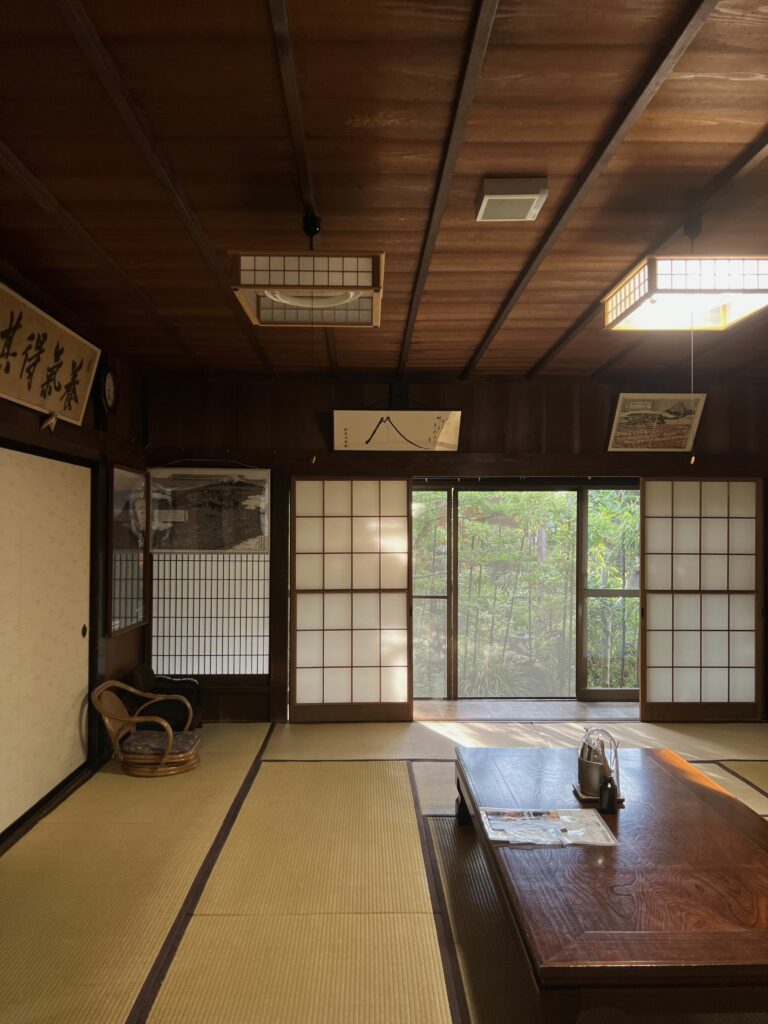
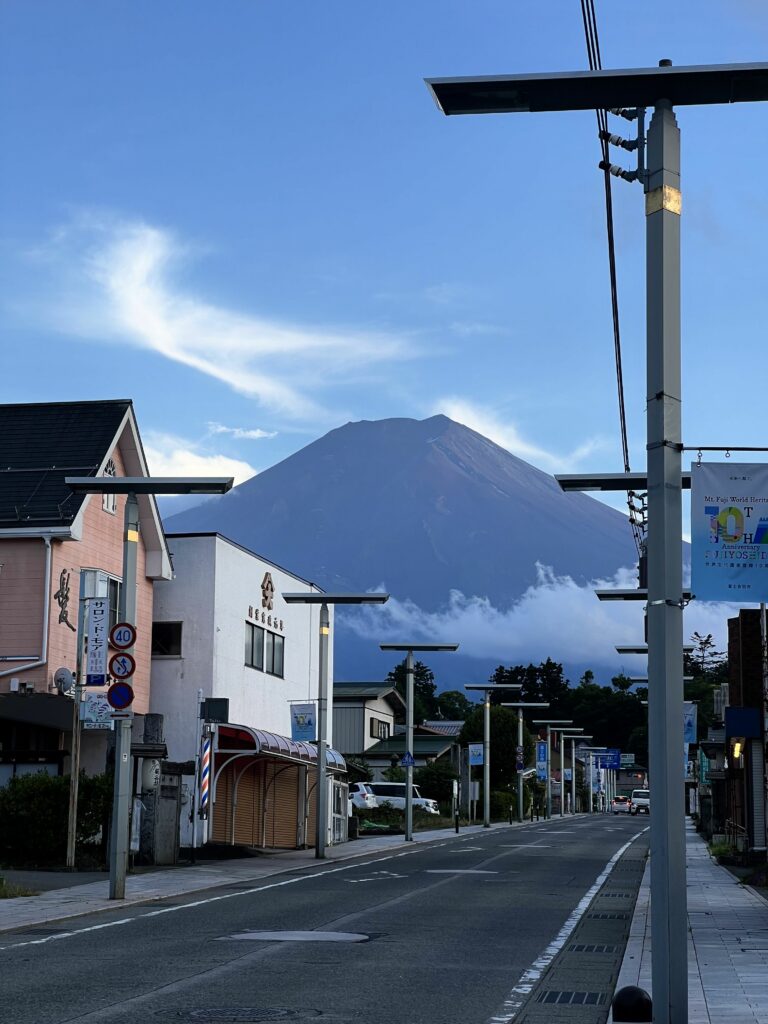
Say hi to Mount Fuji (if you’re lucky).
Fujiyoshishida is the gateway to Mount Fuji, as it’s the location of Mt. Fuji 5th Station, the starting point for Mt. Fuji climbers. Every street in Fujiyoshida is picturesque, as you can see the mountain anywhere you are. There’s a popular Lawson’s near the Kawaguchiko station that offers insanely clear views of the mountain. However, in May 2024, Fujikawaguchiko, the town where the Lawson is located, announced they are building a 2.5-meter-high, 20-meter long black netting blocking the view of Mt. Fuji due to tourist disruptions to locals. Which is a shame, but it’s reasonable considering how affected locals are from noise, dangerous pedestrian crossing, and more. You can also stay in traditional Japanese homes if you choose to stay overnight.
Besides Mount Fuji, Fujiyoshida also houses the famous Fuji-Q Highland amusement park that has the tallest roller coaster in all of Japan, the Fujiyama. If you’re an adventure-seeker, riding the Fujiyama is a must; where else can you get a clear view of an enormous mountain on a rollercoaster?!
Mount Fuji Views
If you’re not up to hiking Mount Fuji, you can get a milder hike with great views of the mountain at Arakurayama Sengen Park. It’s a free park with a picturesque shrine and scenic views of Mt. Fuji. It’s one of the hallmark scenic spots of Japan and is incredibly popular during cherry blossom season as the entire mountain blooms with pink flowers. It takes about an hour to hike up to the park, though, so be prepared!
I did an overnight stay in Fujiyoshida and absolutely loved it! But if you’re short on time, a day trip is very doable, and you’ll see even more than I did. Just hope that when you go, the weather is in your favor! Most of the time, Mount Fuji is shrouded in fog, but if you get lucky, you’ll get a clear view.
How to get there from Tokyo: Take the JC Chuo Line Fuji-Excursion 71 Train from Shinjuku Station to Mt. Fuji Station. It takes 2 hours.
5. Ibaraki Prefecture (One of the Day Trips from Tokyo I Really Want to Go On)
Fun fact: This is Japan’s No. 1 producer and consumer of natto.
Definitely try natto, or fermented soybeans, in the one place that loves it the most. But besides fermented foods, Ibaraki is most well known for its huge Buddha statue, the Ushiku Daibutsu, which is 120 meters tall and the fifth tallest statue in the world. Just to give you a scale of how large it is, the Ushiku Daibutsu is three times larger than the Statue of Liberty! Even cooler, inside the statue is a wall of more than 3,000 gold miniature Buddhas.
Ibaraki is also known for its beautiful nature, where you’ll find multiple parks dedicated to different plants and flowers. The most popular one is the Hitachi Seaside Park in Hitachinaka City, where you’ll find hills covered in blooming sky-blue flowers in the spring and magenta bushes in autumn. Kairakuen Park in Mito City is another famous park, boasting a grove of plum trees that are absolutely stunning when in bloom. It’s also one of the Three Great Gardens of Japan.
You can also see a seaside tori gate at Oarai Isosaki Shrine, where a singular gate stands on a rock facing the Pacific Ocean and is a sight to behold. For more nature, hike Mount Tsukuba or visit the Fukuroda Falls, which is as tall as the Ushiku Daibutsu! Ibaraki is especially beautiful during autumn when the trees change color to Koyo (紅葉) and Momiji (紅葉).
How to get there from Tokyo: Take the JR Hitachi and Tokiwa Hitachi 19 Shinkansen or the Ueno-Tokyo Line from Ueno Station to Mito Station. It takes one hour by Shinkansen (high-speed train) or two hours by local train.
6. Nikko
Escape the city and indulge in scenic landscapes and hiking.
Nikko is a small city north of Tokyo with sacred mountains and a strong relationship with Buddhist worship. Its temples and shrines are UNESCO World Heritage sites that are all within walking distance of each other. Admire the gilded Toshogu Shrine, with its 5-story pagoda, and Futarasan Shrine and its gorgeous Shinkyo Bridge, with its amazing ancient story.
You can spend an entire day just wandering around the religious sites. If you’re looking for more nature, explore the Nikko National Park, which includes the shrines mentioned above. Hike Mt. Nantai, one of Nikko’s highest and sacred mountains, to see stunning views of Lake Chuzenji. There are also various waterfalls that are famous, including Kegon Falls near Lake Chuzenji, which formed from lava flows.
This small city packs a punch of culture, history, and breathtaking scenery. It’s definitely worth visiting, and I wish I had visited on my earlier trip this year. I’ll have to go back!
How to get there from Tokyo: Take the Kegon 33 for Tobu-Nikko local train from Asakusa Station to Shimo-Imaichi Station. It takes an hour and 42 minutes.
7. Hakone
Soak in onsens surrounded by nature…
Hakone is a small mountain town west of Tokyo known for its numerous onsens or hot springs that garner 20 million visitors annually. There are so many onsens in this region due to continual geothermal activity, and all of them are surrounded by great scenery. Take a soak in an onsen and get all the yummy skincare benefits from the mineral water.
There is also the famous Hakone Shrine torii gate that sits on the water’s edge of Lake Ashi, which is incredibly picturesque. It’s called the Tori of Peace and is the first gate that leads up to the actual shrine. It’s a very popular scenic spot, and there are boat cruises that take people around the lake and pass by this iconic view. Surprisingly, the boat cruise is actually a sightseeing pirate ship!
A Pirate Ship?
You can take one of three pirate ships around Lake Ashi, which is a crater lake formed by a volcano eruption hundreds of years ago. Not only is it popular for its torii gate, but it’s well known to have amazing views of Mount Fuji. For even more views, visit Owakudani, a scenic volcanic valley with active sulfur vents and hot springs, and the famous “black eggs” you can eat.
Hakone is packed with lots of sights to see and activities to do, so many people opt to spend 2-3 days here. However, you can definitely do Hakone on a day trip if you pick your spots right!
How to get there from Tokyo: Take the Romancecar Hakone 75 for Hakoneyumoto train from Shinjuku Station to Hakone-Yumoto Station. It takes an hour and a half. From Hakone-Yumoto Station, there are buses you can take to different attractions.
8. Sawara
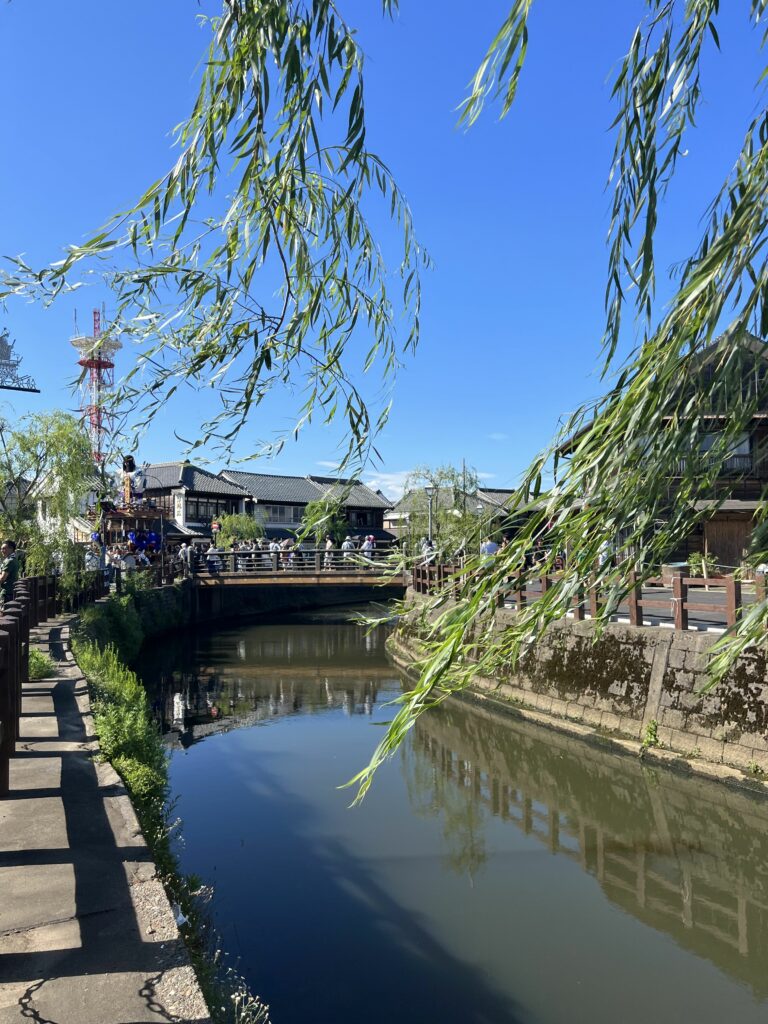
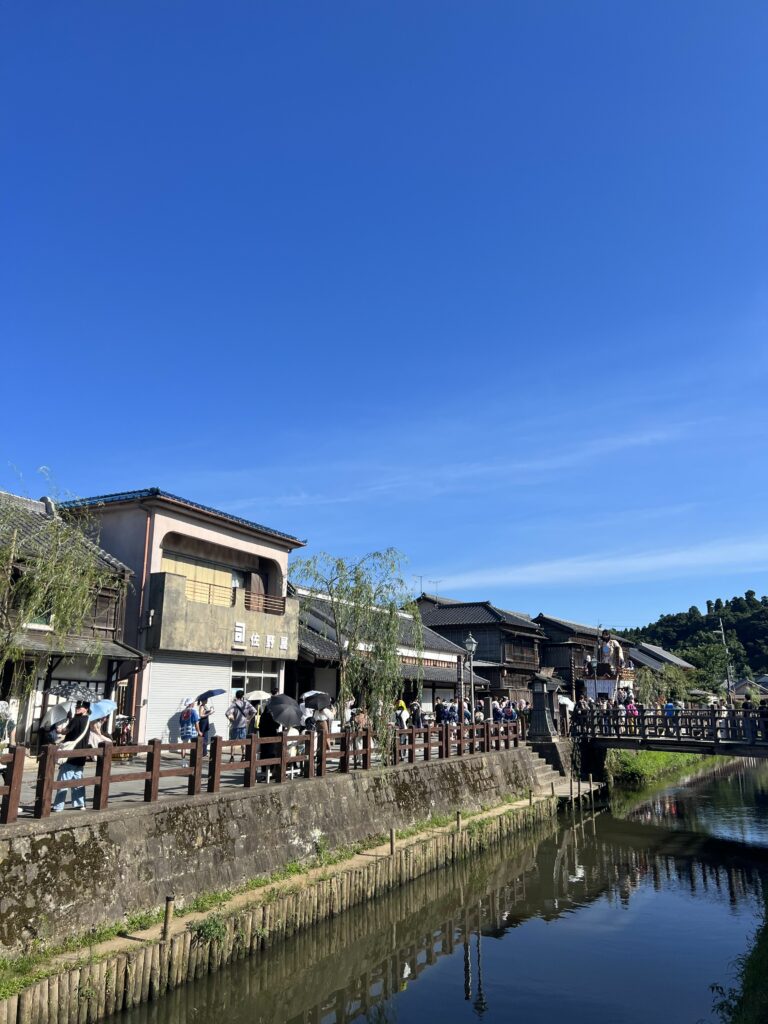
Picturesque canals and buildings that transport you back to the Edo period.
More Edo-period architecture! Sawara is a small city northeast of Tokyo famous for its canals and Edo-period buildings. This merchant town during the Edo period flourished as a rice shipment hub. Take a stroll down the canals in Sawara’s historical district, where you’ll find streets lined with traditional shops and restaurants as well as wisteria trees.
It’s a great piece of history you can experience, especially since the canals are the same canals merchants used hundreds of years ago. There are also several beautiful bridges crossing over the canals that you can walk on. Additionally, you can visit Katori Jingu, one of the oldest Shinto shrines in Japan, and several other shrines that are within walking distance from the JR Sawara station.
Sawara Grand Festival


One of the main attractions in Sawara is the Sawara Grand Festival, which is one of the major float festivals in this region, running for about 300 years. It occurs once in the summer and once in the fall, and it is a sight to behold. The streets fill with floats, dancing, and musical chants called sawara bayashi as the floats move from shrine to shrine. The floats are decorated in wood carvings and large dolls perched atop with people performing on the float itself. It’s an amazing festival to experience and enjoy the local flair, and it’s also a UNESCO Intangible Cultural Heritage.
I visited Sawara during the Grand Festival this year, and it was so lovely. Like Kawagoe, I loved the architecture, and the canals added a historical feel to the atmosphere. There’s a huge street food night market as well, and although it was dreadfully hot, Sawara was a memorable end to my month trip to Japan.
How to get there from Tokyo: Take the Keisei Line from Nippori Station to Keisei-Narita Station, then walk over to Narita Station. It takes an hour. From Narita Station, take the JO Narita Line for Choshi to Sawara Station. It takes 30 minutes.
9. Karuizawa
An escape from the heat or a winter wonderland. It’s the best of both worlds!
Karuizawa is a mountain resort town northwest of Tokyo near Nagano. It became popular as a resort town after a Canadian missionary visited and, blown away by its beauty and cool climate, shared it with other missionaries as a summer retreat. As a result, there are many Western-style buildings in Karuizawa, including churches and hotels that look straight out of Europe. It’s said that the Imperial family of Japan goes to Karuizawa to vacation and retreat, so do as the royals do!
As this is a resort town, there are plenty of places to shop and relax. Haruinire Terrace is a quaint shopping and dining area built on top of a wooden terrace. For more shopping, head to Karuizawa Prince Shopping Plaza, the largest outlet mall in Japan, for more high-end shops. It’s conveniently located right next to the JR station and also has great architecture.
This town is popular in the winter, where skiers, snowboarders, and winter sports lovers flock to the town to catch some powder. In the summer, you can also catch sight of the unique Shiraito Waterfall that resembles hanging silk threads.
How to get there from Tokyo: Take the Hokuriku-Shinkansen for Nagao from Tokyo Station to Karuizawa Station. It takes an hour and sixteen minutes.
10. Yamagata
If you’re a scenic view lover, you’ll want to see this natural beauty.
Just north of Tokyo is a city known for its beautiful nature, where you can see blooming cherry blossoms in spring and the cascade of turning leaves in the fall. Like Hakone, Yamagata also has its share of onsens, and like Karuizawa, it is also a popular resort town. However, Yamgata’s most famous attraction is the Rissyakuji Temple or Yamadera.
Yamadera is an over one thousand-year-old temple complex built into the mountain rockface. Aside from its location, what makes this temple unique is that you have to climb 1000 stairs to get to it. As you make your way to the top of the complex, you’ll pass by many temples, statues, and trees. Once you make it to the top, you’re rewarded with an absolutely gorgeous view of Yamagata, making the trek up worth it. It takes about an hour and a half each way, and more time if you want to stop along the way.
Ginzan Onsen Nearby
More recently, the Ginzan Onsen, a small historic onsen town north of Yamagata City, is rising in popularity. Nestled in the mountains of Yamagata Prefecture, Ginzan Onsen is one of Japan’s prettiest onsen towns, with wooden ryokans lining the Ginzan River. It’s said that this town looks like the onsen in the Studio Ghibli movie Spirited Away! It originated as a silver mining town but now is home to dozens of traditional bathhouses that make you feel like you are in the past.
Yamagata City is a little further from Tokyo and costs a bit more to get to. However, it’s still doable as a day trip if you plan correctly. Wake up early, nap on the train, explore on the train, and then nap again, haha.
How to get there from Tokyo: Take the Saikyo Line for Kawagoe from Shinjuku Station to Omiya Station. It takes 34 minutes. Then, from Omiya Station, take the Yamagata Shinkansen to Yamagata Station. It takes about 2 hours and 20 minutes.
If You’re Ambitious: Hachinohe.
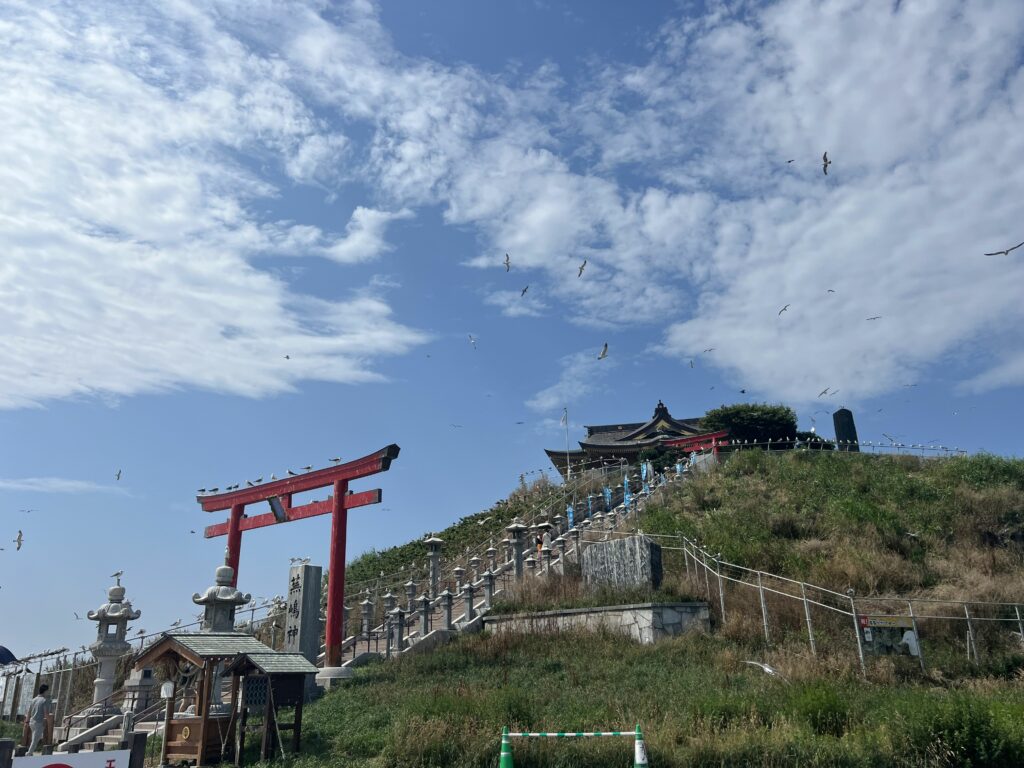
A seagull shrine, or a shrine dedicated to seagulls???
If you have a JR pass and are trying to get all the value you possibly can out of it, then visit Hachinohe in the Aomori Prefecture. Hachinohe is a coastal city in the most northern prefecture on the main island of Japan. It’s famous for its Kabushima shrine located on Kabushima Island, which is the breeding ground for thousands of black-tailed seagulls from spring to late summer. If you go during this season, you’ll see thousands, and I mean thousands, of seagulls flying around the island and temple.
Now, you’re probably thinking that’s crazy, and what about the poop? Well, yes, it is crazy. And the ground is quite literally covered by seagull poop, so much so that the temple provides umbrellas for visitors to protect themselves. But where else can you say has a temple overrun with seagulls? It’s definitely a unique destination.
Seafood and Coastal Views

There’s also a coastal walk by the east coast of Hachinohe called Tanesashi Coast, with amazing views of the Pacific Ocean as well as pristine beaches perfect for swimming or lying. Aomori Prefecture is also known for its seafood, and you can sample some at Hasshoku Center, a giant seafood marketplace with over 60 seafood stalls. It’s also one of the largest indoor markets in Japan. The owner of the hostel I stayed at almost cried when I told him I didn’t eat fresh seafood in Aomori…
Now, I wouldn’t recommend this day trip from Tokyo unless you are ambitious and have a JR pass, as the shinkansen to Hachinohe is expensive. This would be a better day trip from a city in the northern part of Japan. But you might be like me and also want to use your JR pass to its fullest, especially since it will be increasing in price soon!
How to get there from Tokyo: Take the Tohoku Shinkansen from Tokyo Station to Hachinohe Station. It takes 2 hours and 45 minutes.
Day Trips from Tokyo Table
To make it easy, here’s a table comparing all the day trips from Tokyo above.
| Location | Distance from Tokyo (approx.) | Travel Length by Train | Popular Attractions | Go Here if You Like: |
|---|---|---|---|---|
| Kawagoe | 30 km | 1 hour | Little Edo, Hikawa Shrine, Toki no Kane | Historic districts and relaxing vibes |
| Kamakura | 45 km | 1 hour | Komachi-dori Street, Daibutsu at Kotoku-in Temple, Yuigihama Beach | Shopping streets, coastal city vibes, and cool temples |
| Yokohama | 27 km | 1/2 hour | Chinatown, Yokohama Cosmo World, Cup Noodles Factory, Red Brick Warehouse | Walking around a port, fun activities, and good food |
| Fujiyoshida | 92 km | 2 hours | Mount Fuji, Fuji-Q Highland, Arakurayama Sengen Park | Seeing Mount Fuji, scenic views, and a relaxed atmosphere |
| Ibaraki Prefecture | 99 km | 1-2 hours (depending on city destination) | Ushiku Daibutsu, Hitachi Seaside Park, Kairakuen Park, Oarai Isosaki Shrine, Mount Tsukuba, Fukuroda Falls | Beautiful nature! |
| Nikko | 120 km | 1 hour and 30 min | Nikko National Park (Toshogu Shrine, Futarasan Shrine, Shinkyo Bridge), Lake Chuzenji, Kegon Falls | Beautiful temples, shrines, and nature |
| Hakone | 85 km | 1 hour and 42 min | Onsens, Hakone Shrine, Lake Ashi, Pirate Ship Sightseeing, Owakudani | Onsens, lakes, and scenic view |
| Sawara | 70 km | 1 hour and 30 min | Historical District, Katori Jingu, Sawara Grand Festival | Historic districts, slower pace of life, and cultural heritage |
| Karuizawa | 130 km | 1 hour and 16 min | Resorts, Haruinire Terrace, Karuizawa Prince Shopping Plaza, Shiraito Waterfall | Resorts, winter sports, shopping and dining, and relaxing |
| Yamagata | 288 km | ~3 hours | Rissyakuji Temple (Yamadera) and Ginzan Onsen (nearby) | Scenic views, temples, and picturesque places |
| Hachinohe | 560 km | 2 hours and 45 min | Kabushima Shrine, Hasshoku Center, Tanesashi Coast | Unique attractions, seafood, and coastal views |
Plan Your Day Trips from Tokyo
Phew, that was a long one. After doing research on all these places, I really wish I could be in Japan right now to visit them! There are so many places you can visit near Tokyo that are fun and unique. While Kyoto and Osaka are amazing cities, and you should definitely visit them if you can, I wanted to introduce some other places you should consider for a day trip. Whether you choose a city known for its historic architecture, beautiful nature, or relaxing feel, you’ll have a great time. If you want more guidance on how to plan an amazing trip to Japan, check out my blog about all you need to know for planning the best trip to Japan. Happy travels!
Relevant Reads
The BEST 16 Things to Do in Busan for an Exciting, Epic Trip





